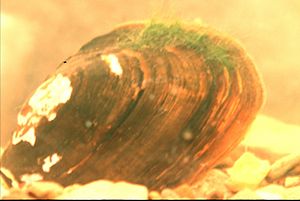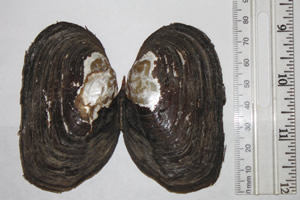Carolina heelsplitter facts for kids
Quick facts for kids Carolina heelsplitter |
|
|---|---|
 |
|
| Conservation status | |
| Scientific classification | |
| Genus: |
Lasmigona
|
| Species: |
decorata
|
The Carolina heelsplitter (Lasmigona decorata) is a type of freshwater mussel. It is an aquatic bivalve mollusk that lives in rivers and streams.
It got its name "Carolina heelsplitter" because its shell has a sharp edge. This edge sticks out from the riverbed and could cut someone's foot if they walked on it.
This mussel is found only in the United States, specifically in North Carolina and South Carolina. It is considered "critically endangered," which means it faces a very high risk of disappearing from the wild soon.
Contents
What the Carolina Heelsplitter Looks Like
The first time a Carolina heelsplitter was officially recorded was in 1852 by Isaac Lea. He called it Unio decoratus. The biggest one ever found was about five inches long.
This freshwater mussel has a shell that is greenish-brown to dark brown on the outside. The inside of the shell is usually shiny white or bluish-white. Older mussels might have a pale orange inside. Younger ones often have faint black or greenish-brown stripes on the outside of their shell.
This mussel is medium-sized. It has thin, delicate "teeth" inside its shell that help it open and close. The Carolina heelsplitter has two blade-like teeth in its left shell half and one in its right shell half.
The largest Carolina heelsplitter found was about 4.6 inches long, 1.56 inches wide, and 2.7 inches tall. Its shell is shaped like an oval or a trapezoid and is smooth.
Protecting the Carolina Heelsplitter
This mussel was declared an endangered species on June 30, 1993. This happened because its home was being destroyed or changed. Also, people were using it too much for different reasons, and other natural or human-made problems were affecting it. Experts reviewed the species' recovery on July 28, 2006.
A plan to help the species recover was created in January 1997 by John A. Fridell. The main goals were to use government rules to protect the mussel and teach people about it. They also wanted to find new groups of mussels and create six healthy populations. The plan aimed to remove major threats so the mussel would no longer be endangered.
When the recovery plan was written, only four groups of Lasmigona decorata were known. These groups were very small and spread out. Much of the mussel's old habitat in the Catawba, Pee Dee, Saluda, and Savannah River systems was no longer suitable. The plan stressed that the mussel groups needed to be large enough so that one big event wouldn't wipe them all out.
Carolina Heelsplitter Life Cycle
The Carolina heelsplitter's life cycle starts when the male mussel releases its sperm into the stream. Female mussels then take in the sperm, a process called siphoning. The female's eggs, which are kept in her gills, are then fertilized.
When the baby mussels, called glochidia (larvae), are ready, the female releases them into the water. These tiny larvae must quickly attach themselves to a host fish. The fish is not harmed by this. We still don't know which fish species is the host for this mussel.
While attached to the fish, the young heelsplitters get oxygen and food for several weeks. Once they grow into fully developed juvenile mussels, they let go of the fish. Then, they settle down into the stream or riverbed.
A host fish is very important for all mussels. It gives the young mussels food and oxygen. It also helps transport them to new places. This transportation is key for creating new mussel groups in different streams and riverbanks.
Where the Carolina Heelsplitter Lives
The Carolina heelsplitter lives in shallow streams and rivers. Sometimes, it can be found in ponds. These mussels usually live in mud or mixed sand and mud. They are often found along stable riverbanks but can also be in the middle of a waterway. It is important that the water does not carry too much dirt or sediment.
Historically, the Carolina heelsplitter was found in the Catawba River and Pee Dee River systems in North Carolina. It also lived in the Pee Dee and Savannah River systems of South Carolina. It might have also lived in the Saluda River systems in South Carolina.
Before a drought in 2007-2008, there were ten known groups of these mussels in North and South Carolina. These areas include Goose Creek and Flat Creek in the Pee Dee River system. They are also in Waxhaw Creek, Sixmile Creek, Gills Creek, Fishing Creek, and Bull Run Creek in the Catawba River system. Finally, they are in Red Bank Creek, Turkey Creek, and Cuffytown Creek in the Saluda River system.
John A. Fridell reported that the number of mussels in each group is very small:
- Most groups had only 1 to 17 mussels. Four of these groups had only 1 to 5 mussels.
- One group had 26 mussels.
- The largest group had only 42 mussels.
These numbers show that the species is declining. Also, none of the groups have grown larger over time. John A. Fridell also noted that the groups are very spread out and isolated. They have only been found in short parts of streams.
Many things together are causing the decline and endangerment of Lasmigona decorata. The biggest reasons are too much sediment and pollution in streams. Road building, runoff from land, mining, and other human activities also cause problems.
Why the Carolina Heelsplitter is Endangered
Small Population Size
One of the main reasons the Carolina heelsplitter is at high risk of extinction is its small population size. The number of mussels in each group is low. Also, these groups are far apart, so the mussels don't have many chances to mix their genes. This means they might not have enough genetic variety to adapt well to natural changes or human-made problems.
Water Pollution
Clean water is very important for Carolina heelsplitters. Chemical water pollution is a serious threat. This can come from runoff, people dumping trash or chemicals into streams and rivers, and other sources. Baby mussels are very sensitive to high levels of copper and ammonia. They seem to handle slightly higher levels of chlorine better. High levels of ammonia, chlorine, and copper were found in some areas, possibly due to rain washing more sediment into the water.
Habitat Degradation
The Carolina heelsplitter now lives in shallow streams and rivers, usually one to four feet deep. The water needs to be clear, without pipes, dams, or anything that blocks the river's flow. The rivers must have lots of oxygen and many tiny organisms and plants for the mussels to eat.
These mussels need to live near very stable riverbanks. Banks that crumble not only take away the mussels' home but also mean fewer plants and trees are holding the soil in place. Any increase of dirt or sediment in the water can harm the mussels. Too much sediment can smother and kill them.
Any human development, like bridges built near rivers, greatly disturbs the delicate balance of sediment in the water.
Plants along the river and stream sides also help keep the water cool during hot summers. They also provide decaying leaves and plants, which are essential for all living things in the water.
Human Development
Building and changing rivers greatly affect the Carolina heelsplitter. Activities like straightening rivers, building dams, and digging up riverbeds directly destroy their homes.
The Fish Host
If scientists can find out which fish species hosts the Carolina heelsplitter larvae, they can check if that fish is also endangered or being overfished. This information would help protect both the mussels and their host fish.
See also
 In Spanish: Lasmigona decorata para niños
In Spanish: Lasmigona decorata para niños



